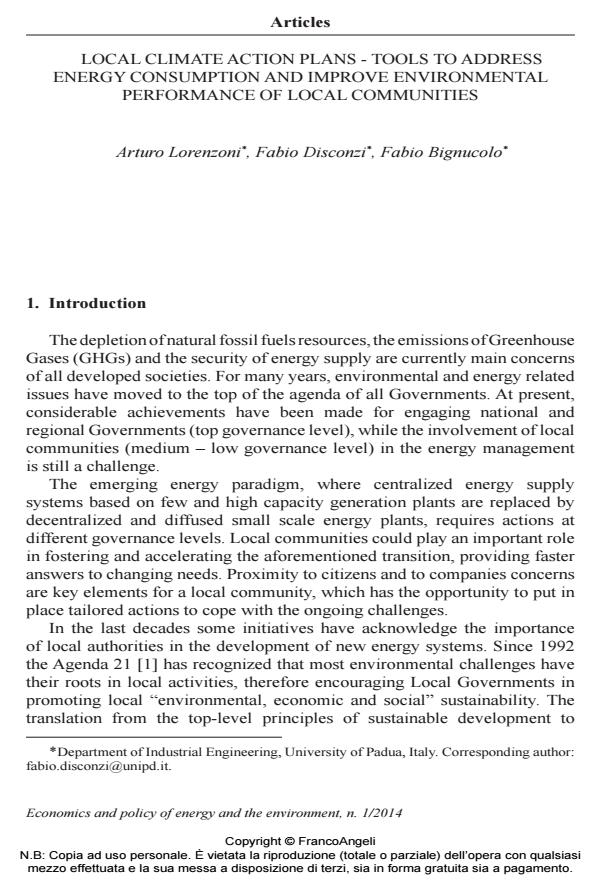Local Climate Action Plans - Tools to Address Energy Consumption and Improve Environmental Performance of Local Communities
Titolo Rivista ECONOMICS AND POLICY OF ENERGY AND THE ENVIRONMENT
Autori/Curatori Arturo Lorenzoni, Fabio Disconzi, Fabio Bignucolo
Anno di pubblicazione 2014 Fascicolo 2014/1 Lingua Inglese
Numero pagine 29 P. 63-91 Dimensione file 408 KB
DOI 10.3280/EFE2014-001004
Il DOI è il codice a barre della proprietà intellettuale: per saperne di più
clicca qui
Qui sotto puoi vedere in anteprima la prima pagina di questo articolo.
Se questo articolo ti interessa, lo puoi acquistare (e scaricare in formato pdf) seguendo le facili indicazioni per acquistare il download credit. Acquista Download Credits per scaricare questo Articolo in formato PDF

FrancoAngeli è membro della Publishers International Linking Association, Inc (PILA)associazione indipendente e non profit per facilitare (attraverso i servizi tecnologici implementati da CrossRef.org) l’accesso degli studiosi ai contenuti digitali nelle pubblicazioni professionali e scientifiche
Achieving the ambitious 2020 targets in greenhouse gases’ emissions reduction is a challenging task for industrialized economies and requires a coordinated action. A pivotal role is given to local administrations, that are called to drive the conversion of the energy sector towards low carbon technologies. The paper proposes a decision support tool based on local climate action plans for a holistic approach to the emission reduction in different energy intensive sectors (transport, constructions, electricity supply, energy generation). The tool is aimed at identifying suitable measures for the design and control of GHG actions. A set of indicators to evaluate the performance of local policies, linked to GIS based maps for an effective impact on territories is proposed. A smart use of existing information can help to optimize the energy supply at local level, to follow the improvement of performances and to weigh future scenarios.
Keywords:Climate action plan, environmental rating, GIS based indicators
Jel codes:Q580, Q550, R580
- United Nations - Sustainable Development. (1992). Agenda 21 - United Nations Conference on Environment & Development, Rio de Janeiro, Brazil, 3 to 14 June 1992.
- Covenant of Mayors Office. Covenant of Mayors. Retrieved from http://www.covenantofmayors.eu/.
- Aalborg Commitments. Retrieved from: http://www.sustainablecities.eu/. Global City Indicators Program. Retrieved from: http://www.cityindicators.org/. C40 - Cities Climate Leadership Group. C40 Cities. Retrieved from http://www.c40cities.org/. ICLEI - Local Governments for sustainability. Retrieved from: http://www.iclei.org/.
- Sustainable European Regions Network (2004). Cohesive Thinking Towards a Sustainable Future.
- United Nations (2007). Indicators of Sustainable Development: Guidelines and Methodologies. Third Edition.
- Singh R. K., Murty H. R., Gupta S. K., Dikshit A. K. (2009). An overview of sustainability assessment methodologies. Ecological Indicators. DOI: 10.1016/j
- ecolind.2008.05.011. Neves A. R., & V., L. (2010). Energy sustainability indicators for local energy planning: Review of current practices and derivation of a new framework. Renewable and sustainable energy review. DOI: 10.1016/j.rser.2010.07.067
- Sharifi A., Murayama A. (2013). A critical review of seven selected neighbourhood sustainability assessment tools. Environmental impact assessment review. DOI: 10.1016/j.eiar.2012.06.006
- Doukas H., & al., e. (2012). Assessing energy sustainability of rural communities using principal component analysis. Renewable and sustainable energy reviews. DOI: 10.1016/j.rser.2012.01.018
- Poveda C. A., Lipsett M. G. (2011). A Review of Sustainability Assessment and Sustainability/Environmental Rating Systems and Credit Weighting Tools. Journal of Sustainable Development. USGBC. LEED Rating Systems. Retrieved from: http://www.usgbc.org/leed/ratingsystems.
- Green Building Council Italia. (2011). Manuale GBC Home - Edifici residenziali.
- Neama W. A. (2012). Protect the planet through sustainability rating systems with local environmental criteria - LEED in the Middle East. Procedia - Social and behavioral Sciences. DOI: 10.1016/j.sbspro.2012.12.264
- Obermeyer N. J. (1995). PPGIS: The Evolution of Public Participation GIS.
- Kingston R., & al, e. (2000). Web-based public participation geographical information systems: an aid to local environmental decision-making. Computers, Environment and Urban Systems. DOI: 10.1016/S0198-9715(99)00049-6
- Tietemberg T. (1998). Disclosure strategies for pollution control. Environmental and resource economics. DOI: 10.1023/A:1008291411492
- Wang H. et al. (2004). Environmental performance rating and disclosure: China’s GreenWatch program. Journal of Environmental Management. DOI: 10.1016/j.jenvman.2004.01.007
- Climate UK. (2012). Planning for climate change - Guidance for local authorities. Canadian International Development Agency (2012). Indicators for Sustainability - How cities are monitoring and evaluating their success
- Parag Y. et al. (2013). Network approach for local and community governance of energy: the case of Oxfordshire. Energy Policy. DOI: 10.1016/j.enpol.2013.06.027
- The natural step framework. Retrieved from: http://www.naturalstep.org/sv/.
Arturo Lorenzoni, Fabio Disconzi, Fabio Bignucolo, Local Climate Action Plans - Tools to Address Energy Consumption and Improve Environmental Performance of Local Communities in "ECONOMICS AND POLICY OF ENERGY AND THE ENVIRONMENT" 1/2014, pp 63-91, DOI: 10.3280/EFE2014-001004